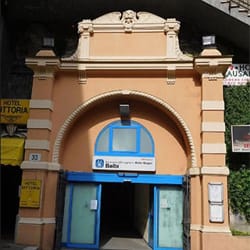By naming the word taxi in London, one immediately thinks of black taxis, or black cabs, one of the many symbols of the city and perhaps one of the most expensive means of transport in town.
Their activity is strictly controlled both as regards the mechanical integrity of the vehicle and the physical and mental integrity of the driver.
Spacious, almost always black (but now there are also other colours such as green or dark red or often black cabs entirely covered by advertisements) they have a glass that separates the clients from the driver, and they are very long-lived machines, some even reach up to 20 years.
Cab drivers in London are often called cabbies.
Never get in cabs that don't have the green badge and beware of those who stop in the middle of the road to ask if you need a taxi, because they never do it so they are probably not licensed.
If the taxi sign is on (the one on the car roof) then the taxi is free, if off, obviously it is already taken! You can hail a cab by stretching out your arm as you do to stop a bus.
The maximum number of people who can get on board is five.
The origin of these taxis dates back to the 1600s when the first public carriages were introduced, which were old carriages in disuse of aristocrats who were transporting people for a fee.
The first taxi license dates back to 1662.
They were the forerunners of the French carriages that were introduced around 1820.
The word cab comes from the French word for goat, as these carriages were very light and skipped around the streets.
The first taxi without horses was the Bersey, introduced in 1897 and was electric followed by the first taxi with the combustion engine that came out in 1903.
In 1947 the last horse-drawn carriage disappeared and the regulations of this trade then passed under the regulations of the London police, the so-called metropolitan police.
In 1891 Sir Wilhelm Bruhn invented the taximeter from which he took the word taxi, which measures the distance and time taken for the distance travelled therefore establishing a price.
The word indeed derives from the French taxe (price) and from the Greek word metron (measure).
It is said that not all London drivers at the time were happy with this taximeter and truth is that they threw Bruhn into the Thames even though his invention is still in use today.
And it is used worldwide.
There are now also mini cabs in London, private taxis, which can, however, load passengers by appointment, generally taken from the agencies they work for, precisely called minicab office. It’s perhaps a direct consequence to the introduction of Uber services which are creating a big competition for cabs in the United Kingdom and worldwide.
The minicabs drivers too must be in possession of a license and such license is issued by the Public Carriage Office but, unlike the black cabs, they drive regular cars.
It is advisable to ask in advance for the price of the ride as they are not equipped with taximeters.
In order to see if a private taxi (or minicab) is legit and licensed, it must have a round yellow sticker on display on the windshield and one on the rear of the car as well.
Clearly traveling and visiting London by taxi has a much higher cost than traveling by metro or bus but it is very cool to ride on a black cab especially for a tourist visiting the city.

Black cabbie






























































